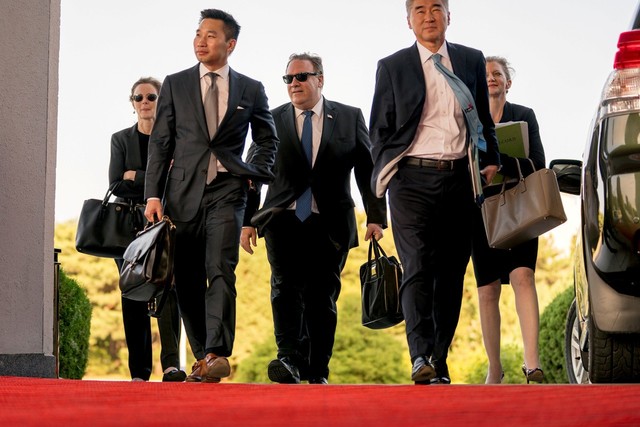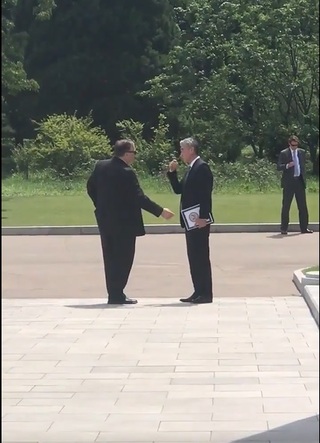 |
|
The US negotiation delegation heads back into the Paekhwawon State Guesthouse in Pyongyang after stepping outside to talk briefly in private during high-level talks on July 6. Pictured from the left are Lisa Kenna, Executive Secretary of the United States Department of State; Alex Wong, Deputy Assistant Secretary for the Bureau of East Asian and Pacific Affairs; Secretary of State Mike Pompeo; US Ambassador to the Philippines Sung Kim; and NSC Korea Director Allison Hooker. (Reuters/Yonhap News)
|
Although critical of US approach, Pyongyang expresses willingness to continue talks
North Korea’s reaction to the results of the high-level talks aimed at implementing the June 12 joint statement between US Secretary of State Mike Pompeo and Korean Workers’ Party Vice Chairman Kim Yong-chol that were held at the Paekhwawon State Guesthouse in Pyongyang between July 6 and 7 boils down to two points. The first is disappointment and concern. The second is a complaint and a warning that the trust and feelings that were built during the summit between North Korean leader Kim Jong-un and US President Donald Trump and the statement they released on June 12 must not be damaged “by the old-fashioned methods of working-level experts.” First, the disappointment and concern. In a Foreign Ministry spokesperson’s statement shortly after Pompeo left Pyongyang, North Korea declared, “Our hopes and expectations were so naive as to be gullible.” It also described the outcome of the talks as “apprehensive.” Unlike his first two visits to the North, Pompeo did not meet with Kim Jong-un, and no “new agreement” was reached. That fact, and the references to the US’s “unilateral and gangster-like denuclearization demands” in the “statement,” provides a clear indication of Pyongyang’s disappointment. There was some progress. Talks on the return of remains from US POW/MIA in the Korean War were scheduled to take place in Panmunjeom on July 12, and Pompeo announced plans to hold working-level talks shortly on the issue of shutting down the North’s missile engine testing site. It amounts to a token of good will from Pyongyang, indicating its commitment to following through on fast agreements. But once it became apparent Pompeo had arrived in North Korea “empty-handed,” Pyongyang offered no gifts of its own. It was the bare minimum to avoid the talks being described as breaking down – a troubling situation for those who looked forward to Pompeo’s third visit injecting new momentum in the two sides’ implementation of their June 12 joint statement. At the “talks,” North Korea released a statement claiming to have proposed “constructive approaches to the balanced implementation of all terms in the Joint Statement”: engaging in various forms of exchange to improve North Korea-US relations (“establishing new US-DPRK relations” according to item 1 in the Joint Statement), declaring an end to the Korean War for the 65th anniversary of the armistice agreement (item 2 on “efforts to build a lasting and stable peace regime”), halting ICBM production and dismantling the engine test site as physical proof (item 3 on “working toward complete denuclearization”), and quickly beginning working-level talks toward the excavation of US soldier remains (item 4 on “recovering and repatriating POW/MIA remains.”
 |
|
US Secretary of State Mike Pompeo (left) and US Ambassador to the Philippines Sung Kim talk outside the Paekhwawon State Guesthouse during high-level talks with North Korean officials. The journalist who took the image, Nicholas Wadhams of Bloomberg, suggested they stepped outside out of concerns of the guesthouse was wiretapped.
|







